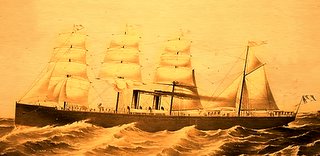10. First Pacific Crossing (1881)
Alternatively, by the late 1870’s, Chinese merchants began to sell “credit tickets.” Emigrants who used the credit tickets agreed to repay the cost of the ticket with interest after securing employment in the
"
 ... From the time of leaving Shanghae, the expenses of provisions and vessel are all to be defrayed by the head of the Tseang Sing Hong. On arrival, it is expected that the foreign merchant will search out and recommend employment for the said labourers, and the money he advances on their account, shall be returned when the employment becomes settled. The one hundred and twenty-five dollars passage money, as agreed by us, are to be paid to the said head of the said Hong, who will make arrangments with the employers of the coolies, that a moiety of their wages shall be deducted monthly until the debt is absorbed, after which they will receive their wages in full every month..."
... From the time of leaving Shanghae, the expenses of provisions and vessel are all to be defrayed by the head of the Tseang Sing Hong. On arrival, it is expected that the foreign merchant will search out and recommend employment for the said labourers, and the money he advances on their account, shall be returned when the employment becomes settled. The one hundred and twenty-five dollars passage money, as agreed by us, are to be paid to the said head of the said Hong, who will make arrangments with the employers of the coolies, that a moiety of their wages shall be deducted monthly until the debt is absorbed, after which they will receive their wages in full every month..."Today a trip to
 (1a-c) During the voyage, emmigrants endured poor and overcrowded conditions (adapted from The Chinese American Album).
(1a-c) During the voyage, emmigrants endured poor and overcrowded conditions (adapted from The Chinese American Album).
It was under these conditions in 1881 at fourteen years of age that Dong Hin boarded the Pacific Mail Steamship Company's steam-fitted schooner the "City of Peking" bound for San Francisco and the “ (2) The "City of Peking" was built in 1873 and was the first iron-hulled, propeller-driven steamer built for the Pacific Mail Steamship Company (from the APL website).
(2) The "City of Peking" was built in 1873 and was the first iron-hulled, propeller-driven steamer built for the Pacific Mail Steamship Company (from the APL website).
Links
The Chinese American Album by Dorothy & Thomas Hoobler
"On Gold Mountain" exhibition
Chinese San Francisco, 1850-1943 by Yong Chen


0 Comments:
Post a Comment
<< Home